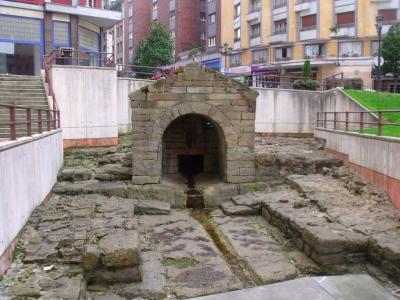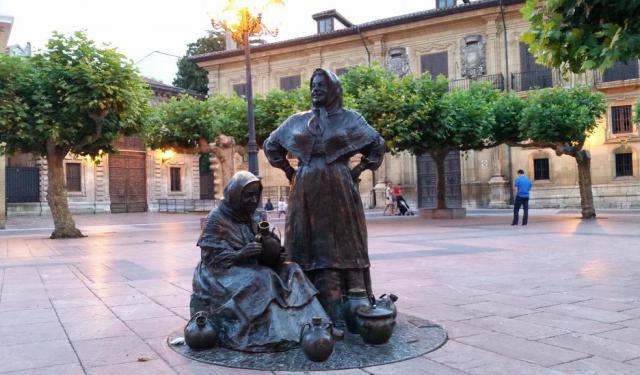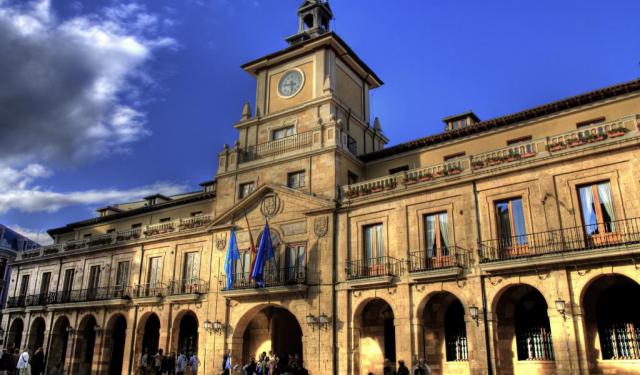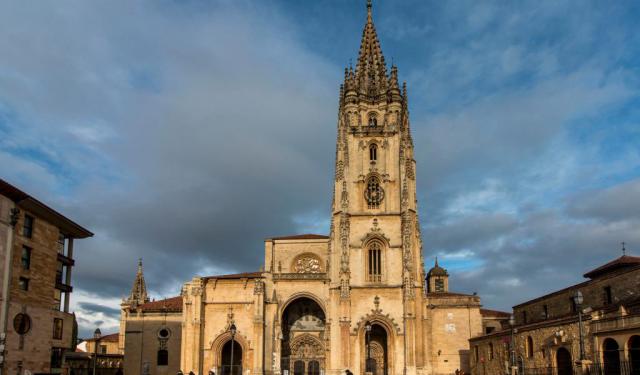Fuente de Foncalada (Foncalada Fountain), Oviedo
Foncalada Fountain is an extraordinary relic of Asturian heritage that quietly bridges the ancient, medieval, and modern eras. Commissioned by King Alfonso III in the 9th century and built atop a natural spring, this stone pavilion served as a public drinking fountain for the people of the capital of the Kingdom of Asturias. Its name derives from the Latin "fontem calatam", meaning “invoked fountain”, a nod to the mystical and symbolic weight its waters held across centuries.
Architecturally, the fountain is a modest rectangle of roughly four metres in width, topped by a pitched gabled roof and fronted by a semicircular arch framed in finely cut voussoirs. Above the entrance sits the Victory Cross of Asturias, flanked by inscriptions invoking divine protection-“With this sign the pious are protected… Lord, put the sign of salvation on this fountain…”-invoking the religious symbolism of Alfonso III’s reign.
Scholars now believe that the extant medieval pavilion was built upon Roman foundations, possibly part of a ceremonial bath complex associated with healing waters. The first written record of the structure appears in the late 11th century, but its significance was so enduring that it has been preserved as the oldest civil monument in continuous use in Spain.
Designated in 1998 as part of the UNESCO World Heritage ensemble Monuments of Oviedo and the Kingdom of the Asturias, the Foncalada Fountain is included among the region’s most significant early medieval landmarks.
Architecturally, the fountain is a modest rectangle of roughly four metres in width, topped by a pitched gabled roof and fronted by a semicircular arch framed in finely cut voussoirs. Above the entrance sits the Victory Cross of Asturias, flanked by inscriptions invoking divine protection-“With this sign the pious are protected… Lord, put the sign of salvation on this fountain…”-invoking the religious symbolism of Alfonso III’s reign.
Scholars now believe that the extant medieval pavilion was built upon Roman foundations, possibly part of a ceremonial bath complex associated with healing waters. The first written record of the structure appears in the late 11th century, but its significance was so enduring that it has been preserved as the oldest civil monument in continuous use in Spain.
Designated in 1998 as part of the UNESCO World Heritage ensemble Monuments of Oviedo and the Kingdom of the Asturias, the Foncalada Fountain is included among the region’s most significant early medieval landmarks.
Want to visit this sight? Check out these Self-Guided Walking Tours in Oviedo. Alternatively, you can download the mobile app "GPSmyCity: Walks in 1K+ Cities" from Apple App Store or Google Play Store. The app turns your mobile device to a personal tour guide and it works offline, so no data plan is needed when traveling abroad.
Fuente de Foncalada (Foncalada Fountain) on Map
Sight Name: Fuente de Foncalada (Foncalada Fountain)
Sight Location: Oviedo, Spain (See walking tours in Oviedo)
Sight Type: Attraction/Landmark
Guide(s) Containing This Sight:
Sight Location: Oviedo, Spain (See walking tours in Oviedo)
Sight Type: Attraction/Landmark
Guide(s) Containing This Sight:
Walking Tours in Oviedo, Spain
Create Your Own Walk in Oviedo
Creating your own self-guided walk in Oviedo is easy and fun. Choose the city attractions that you want to see and a walk route map will be created just for you. You can even set your hotel as the start point of the walk.
Oviedo Public Art Walking Tour
Public art adds a great deal of vibrancy and character to the cityscape of Oviedo, Spain, reflecting, among other things, its contemporary spirit. From the bustling Plaza Trascorrales to the serene Plaza Porlier De Oviedo, numerous sculptures have long become an integral part of the neighborhood, captivating passers-by in their numbers.
In Plaza Trascorrales, sculptures like The Fishwife and... view more
Tour Duration: 3 Hour(s)
Travel Distance: 3.0 Km or 1.9 Miles
In Plaza Trascorrales, sculptures like The Fishwife and... view more
Tour Duration: 3 Hour(s)
Travel Distance: 3.0 Km or 1.9 Miles
Oviedo Historic Architecture
The north Spanish region of Asturias and particularly its capital city, Oviedo, have long been noted for their unique architecture. The medieval part of town, whose ancient walls are still largely intact, contains some truly priceless relics. Among them is a well called La Foncalada, a fascinating example of an effective hydraulic system, dating back to the first half of the 9th century, based on... view more
Tour Duration: 2 Hour(s)
Travel Distance: 2.7 Km or 1.7 Miles
Tour Duration: 2 Hour(s)
Travel Distance: 2.7 Km or 1.7 Miles
Oviedo Introduction Walking Tour
The Kingdom of Asturias began in 720, with the Visigothic revolt against Muslim rule led by the nobleman Pelagius. At that time, the city of Oviedo did not exist. Two monks, Maximo and Fromestano, founded the city in 761. They built a small church for Saint Vincent on a bare hillside, and from this seed, Oviedo grew.
After Pelagius died in 737, King Alfonso I founded a dynasty in Oviedo that... view more
Tour Duration: 1 Hour(s)
Travel Distance: 1.8 Km or 1.1 Miles
After Pelagius died in 737, King Alfonso I founded a dynasty in Oviedo that... view more
Tour Duration: 1 Hour(s)
Travel Distance: 1.8 Km or 1.1 Miles






